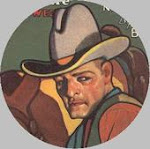Except for the infrequent appearance of new anthologies of western short stories -- which typically include a mix of new tales and reprints -- the outlets for short-form western fiction have dwindled drastically from the days when pulp-paper magazines appeared fresh on newsstands every week with new adventures to thrill and encourage a chuckle from readers for the grand sum of 10 cents.
Street & Smith’s Western Story Magazine was published weekly with cover-featured stories by Max Brand (Frederick Faust) and Walt Coburn; Dime Western, Star Western, Frontier, Lariat, and many others brought readers stories by authors whose names continue to appear on new paperback compilations -- Les Savage, Jr.; Dane Coolidge; Dan Cushman; Peter Dawson; T.T. Flynn; Ernest Haycox; Robert J. Horton; William Colt MacDonald; and more.
Even slick-paper magazines like Saturday Evening Post, Colliers, and Liberty included westerns by Luke Short, Zane Grey, Alan LeMay, and others.
I’ve suggested elsewhere that westerns probably accounted for more ink being pressed onto pages than any other genre of fiction. That’s certainly not the case now.
But short western fiction has an online presence at a few Web sites. Rope and Wire is one, which I’ll examine in a future post. Another, Reflection’s Edge, isn’t dedicated to westerns alone, but spotlights a number of genres. (It seems to lean more toward SF and fantasy, but some western work can be found there.)
Fans of western reading shouldn’t dismiss all online fiction simply because it doesn’t have the permanence of a bound format. There’s a lot of good reading to be had from online sources.
For instance, “The Devil and Strap Buckner,” by Evan Lewis, is a dandy western tale on the Reflection’s Edge site from its November 2008 “issue.” It would stand shoulder-to-shoulder with any tall tale that you might find in the pages of Western Story Magazine, Argosy magazine, Short Stories magazine, or any number of others in their heydays.
According to an endnote from Lewis, “Aylett 'Strap' Buckner was a real life Texas hero who became a legend. The story of his fight with the Devil began as oral tradition and first saw print in 1877.” Lewis’ take on the tale is humorous and larger than life, with the right amount of exaggeration and verisimilitude to give any reader a smile and maybe an outloud laugh. The story has an oral quality that appropriately captures the spirit of the tale’s history, and it’s debunking slant (for want of a better term) is right in line with the traditions of this sort of storytelling.
Here’s a pleasant passage that captures the story’s flavor:
<<
To call Strap big was a major understatement, like saying the ocean is wide or the sky is high. Seated there on that log, he might have been mistaken for a mountain with a hat on. Add to this his flame-red hair and freckles, and he was altogether an extraordinary sight.
Strap took a draught from the barrel he used for a whiskey mug, and let out a belch that singed my whiskers. The blacksmith, who had been directly in its path, picked himself up off his keister and began slapping dust from his breeches.
"It works thusly," I said. "Each time a new man moves into the colony, Strap knocks him down. This reminds us lesser mortals what'll result if we don't behave well toward one another." I aimed my pipe stem at the blacksmith. "Since you, mister, have already been knocked down, we'll just proceed to the next feller in your party."
>>
This “Strap Buckner” story reminds us that good western tales aren’t focused just on horses and gunplay. The western is more universal than what's captured in that limited description: it encompasses romance, elegy, tomfoolery, epiphany, heartbreak, war, and more. I hope we’ll soon see more work from Lewis.
Subscribe to:
Post Comments (Atom)






2 comments:
Shucks, Duane. You're like to make me blush.
Post a Comment